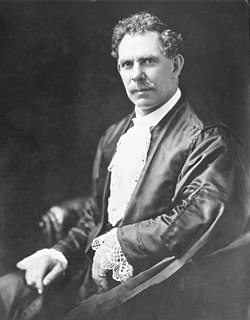
Sir John William Downer, KCMG, KC was an Australian politician who served two terms as Premier of South Australia, from 1885 to 1887 and again from 1892 to 1893. He later entered federal politics and served as a Senator for South Australia from 1901 to 1903. He was the first of four Australian politicians from the Downer family dynasty.

John Abel McPherson was the first leader of the South Australian United Labor Party from 1892 to 1897. Though he never led a government himself, he helped lay the groundwork which ensured that at the 1905 election, Thomas Price would form the world's first stable Labor government. John Verran led Labor to form the state's first of many majority governments at the 1910 election.

John Lloyd (Jack) Price was an Australian politician and trade unionist. He was an Australian Labor Party member of the South Australian House of Assembly for Port Adelaide from 1915 to 1925. He later served in the Australian House of Representatives for Boothby from 1928 until his death in 1941, but left the Labor Party and joined the United Australia Party, following the 1931 Labor split over government responses to the Great Depression.

David Morley Charleston was a Cornish-born Australian politician. Born in St Erth, Cornwall, he received only a primary education before becoming an apprentice engineer at Harvey & Co ironworks, and later an engineering unionist in the Amalgamated Society of Engineers in London. In 1874 he moved to San Francisco and worked as a marine engineer for Pacific Mail Steamship Company. Migrating to South Australia in 1884, he continued his engineering work initially on the Hackney Bridge for the Road Board then with the Adelaide Steamship Company, but resigned in 1887 after labour troubles. He subsequently became President of the United Trades and Labour Council of South Australia for a year from February 1889.
The Herald was a weekly trade union magazine published in Adelaide, South Australia between 1894 and March 1910; for the first four years titled The Weekly Herald. It was succeeded by The Daily Herald, which ran from 7 March 1910 to 16 June 1924.

Frederick Samuel Wallis was a trade unionist and politician in the state of South Australia.
North Adelaide Grammar School, later Whinham College was a private school operated in North Adelaide, South Australia by John Whinham and his family.
The South Australian School of Design was an art school in the earliest days of the City of Adelaide, the progenitor of the South Australian School of Arts, a department of the University of South Australia.

James Laurence Watts (1849–1925) was a sculptor in Queensland, Australia. He was one of the pioneer sculptors in Australia and his works appear in many Queensland public buildings and places.

John McInnes was an Australian politician. He was a member of the South Australian House of Assembly from 1918 to 1950, representing the electorates of West Torrens (1918–1938) and Hindmarsh (1938–1950). He was a member of the Labor Party throughout his career, apart from 1931 to 1934, when he represented the splinter Parliamentary Labor Party. He served as Speaker of the South Australian House of Assembly from 1924 to 1926.
This is a list of members of the South Australian House of Assembly from 1896 to 1899, as elected at the 1896 colonial election:
The Corporate Town of Jamestown was a local government area in South Australia, centred on the town of Jamestown. It was proclaimed on 25 July 1878, severing the seven-year old settlement of Jamestown from the surrounding District Council of Belalie. The first mayor was John Cockburn, later Premier of South Australia, with George Hingston Lake as town clerk. Under the new council, it instituted a tree-planting program from 1879, reportedly the first town in rural South Australia to do so.
The Corporate Town of Gladstone was a local government area in South Australia, centred on the town of Gladstone. It was proclaimed on 8 March 1883, separating the township from the surrounding District Council of Gladstone. It was divided into three wards at its inception, each represented by two councillors. In 1923, it covered an area of 2,243 acres, with a capital value of £137,740. In 1924, it transferred ownership of the Town Hall and the Soldiers' Memorial to the Gladstone Institute. It ceased to exist on 15 May 1933 when it merged back into the District Council. It was expressed at the time that there was local regret at the loss of the distinct town council, but that a decline in rates and reductions in state government expenditure had made it a necessity.
Hedley Allen Dunn was a South Australian architect, a member of the prominent Dunn family of Mount Barker. His work included the flour mill at Port Adelaide for his father and grandfather in 1886, and the Stock Exchange Building on McHenry Street, off Grenfell Street, Adelaide, in 1900.

Lilian Sophia Locke was an Australian trade unionist, political campaigner and suffragette. She has been described as one of the earliest women leaders of the labour movement in Australia.

The Corporate Town of St Peters was a local government area in South Australia from 1883 to 1997.
The Women's Equal Franchise Association (1894–1905) was a women's suffrage organisation in Queensland, Australia. The association was founded in March 1894 at a meeting in the Brisbane Town Hall with approximately 110 members. Mrs John Donaldson was the founding president and Charlotte Eleanor Trundle was the secretary. The initial aim of the association were to secure the right to vote for every adult women.
Rodney Cockburn was a South Australian journalist, author of a popular reference book on South Australian place names.
The Theatre Royal on Hindley Street, Adelaide was a significant venue in the history of the stage in South Australia.

Alexander McKenzie was an Australian rules footballer for Port Adelaide. He was noted to be able to kick a football 75 yards without the assistance of wind.